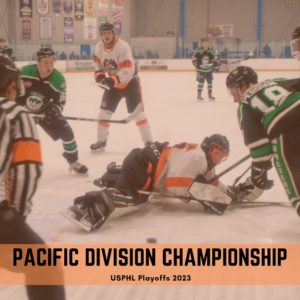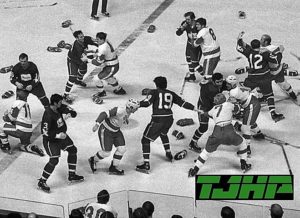We are currently right in the middle of the 2020-21 season. It’s been a season of incredible challenges for league administrators, coaches, parents and players. Some seasons have never gotten off the ground, or have stopped somewhere in the middle of their year to go into quarantine or remote school.
In this month’s article I’ll dive into some of the common myths I’ve seen and experienced with Team Success. I hope it provides some insight to coaches in what has worked (or not worked) for me and the teams I have coached. Further, I hope it comes at a time when players need it, and can apply it to keep engaged in the game if they are not having a complete or full hockey season, and focus with their teams on having the best experience possible.
MYTH #1 Losing Seasons are Failures
Once you learn to quit, it becomes a habit. –Vince Lombardi
The 2015-16 New England Wolves EHL Elite Jr team, my 2nd year as the Head Coach of a Junior team, finished 2nd to last in a 7 team league and barely qualified for post- season play. As a 2nd year organization in the EHL, there was pressure to replicate the success of our first season, but for a variety of reasons we didn’t quite get there. Yet, I look at that season as one of the most important seasons I’ve ever had as a coach. Here’s why…
- In the 2nd half of the season (post New Years), we defeated the eventual champion in Overtime, as well as the 2nd place regular season team in overtime.
- 11 Players from that roster would go on to College Hockey
- We started the JBT Benefit game (winning 7-5 vs the VT Lumberjacks), and raised 4k for the Cure Starts Now Foundation (game is still running and to date has raised over 100k)
- The Following season (2016-17), the core of the team returned and set a franchise record (since surpassed) for wins in a season, and reached the league’s Northern Conference Finals.
Angela Duckworth has done some phenomenal work in the field of mental toughness, and has a great book titled, “Grit: the Power of Passion and Perseverance”. She also has a terrific Ted Talk if you are on youtube.
What makes a bigger impact than talent or intelligence? Mental toughness.
Research is starting to reveal that your mental toughness — or “grit” as they call it — plays a more important role than anything else for achieving your goals in health, business, and life. That’s good news because you can’t do much about the genes you were born with, but you can do a lot to develop mental toughness.
Duckworth’s research has revealed the importance of mental toughness in a variety of fields.
In addition to the West Point study, she discovered that…
- Ivy League undergraduate students who had more grit also had higher GPAs than their peers — even though they had lower SAT scores and weren’t as “smart.”
- When comparing two people who are the same age but have different levels of education, grit (and not intelligence) more accurately predicts which one will be better educated.
- Competitors in the National Spelling Bee outperform their peers not because of IQ, but because of their grit and commitment to more consistent practice. The Science of Developing Mental Toughness in Health, Work, and Life (jamesclear.com)
Wins and Losses are important. It’s how we measure ourselves. Wins and Losses, however, can also be misleading…. I would argue that what positions you or your team and organization best for long-term success is GROWTH. Regardless of the score of this particular 60 minute contest, how does your group look now when compared to a similar 60 minute contest. Have they improved? Are they still working together? Do they still believe in you as a coach? Do they still have a passion for the sport? If you answer yes to these questions during your season, KEEP GOING. Setbacks can be Setups, when you apply the losses correctly.
MYTH #2 The Kids have Changed
We’ve heard this one many times by now. The grizzled veteran coach, or the disgruntled parent complaining about how the coach isnt hard on the players like it was “back in their day”. Or the parent who walked uphill to school both ways. Here are a list of some other things that have changed:
- Howard Florey and Ernest Chain invented Penicillin in 1941 combatting many common bacterial infections.
- In 1938, the first ballpoint pen to be sold was one created by Laszlo Biro.
- Martin Cooper of Motorola placed the first cell phone call in 1973.
- A ‘network of networks’ was initially assembled in 1983 by Robert E. Kahn and Vint Cerf, thereby creating the Internet.
Everything changes. Evolve and get better.
Recognizing that the kids are different and family dynamics are different than a generation ago is important, and equally as important is making sure that you as a coach or administrator effectively gets your content and information across to your customers.
Here are important ways that you can change as an organization and/or as a coach to better communicate with your players.
- Social Media (Twitter, Instagram and Facebook)- use these platforms for emergency communication, notifications, highlights, news and more.
- Apps- DRIVN or Team App (or others). Use these to send communications directly to your players, provide them the schedule (games and practices) on these platforms, and use them for video sessions.
- Zoom Calls- Why do a large group of players/parents meet in person? Everyone has become accustomed to using Zoom in the last year. It’s a safe, easy and effective way to capture your large groups attention.
On the other end of recognizing that kids are different than a generation ago, is the need for an appreciation of what this current generation offers.
Statistics compiled by the Pew Research Center create a clear picture. Here’s what we know:
- Diversity is their norm
- They are our first “digital natives”
- They are pragmatic and financially-minded
- Many factors contribute to their mental health challenges
- They are shrewd consumers
- They are politically progressive – even those on the right
What Are the Core Characteristics of Generation Z? – The Annie E. Casey Foundation (aecf.org)
As a coach trying to move your team forward, it’s important to recognize these challenges and embrace new and different approaches in order to work with this generation of players. Recognize that they are diverse and statistics show this generation is interacting with a larger ethnic spectrum that a generation ago. They use technology… ALL THE TIME. They understand economics and can put the value on something in financial terms to a greater degree than similar athletes could 20 years ago. Mental Health is important to them, and bullying/ hazing is not tolerated. They are forward thinkers.
Here’s an example of how to engage this audience. 30 years ago my father would have his baseball team over every spring training in New Jersey for a cookout. They would watch the 1986 NY Mets championship VHS and enjoy some valuable team building time. They talked about grit, determination, and perseverance. About not quitting. About never giving up.
These events can still happen and are extremely valuable, but you may need to send a shorter, more direct video to their phones and you may need to offer a more diverse menu. In the end though… the message will remain the same. Build the team, sacrifice for one another, and persevere. Once teams do that, they can be successful with any generation.
MYTH #3 Not Every Age can benefit from Video Meetings
“My team doesn’t have the attention span to watch game tape.”- Quote said by a Lakes Region of NH High School Hockey Coach
How important is it for players to review game and practice footage? Is it critical to team success? Do players learn and then implement the information they receive from watching themselves in action? Let’s take a look at how Google Trains its employees…
At Google, 80% of all tracked training is run through an employee-to-employee network called “g2g” (Google-to-Google). The “g2g” learning program is created to offer first-hand knowledge in different fields, from employees to employees.
What makes the program so successful? Summed up in one sentence, it promotes a culture that values learning. First, Google acknowledges the employees’ right to learn. Second, it gives them an opportunity to grow with an on-the-job-training and allows them to give back to other employees by participating in the program. Finally, with the g2g program, the company trusts its employees “to be smart, capable and motivated and have the capacity to grow the organization’s learning culture. 7 Things You Should Know About Google’s g2g Training Method – The Vibons Blog
Google also uses what it calls bite-sized lessons in what they term their “whisper-course”, which provides its employees with ongoing information in short durations so the info sticks.
Sitting in a room or office with your peers and watching each other play is, in my opinion, incredibly valuable. Sharing clips of players on an app or through email, individually or to the team is immensely important. Not only does it reinforce what you are teaching, but it also creates peer to peer learning and team accountability.
Can your team succeed without it? Perhaps…but think about how much better they can be with it. Furthermore, kids learn and absorb information in different ways. They can be physical learners, auditory, verbal, logical or what the majority of humans are… Visual Learners.
Making up about 65% of the population, visual learners absorb and recall information best by seeing. Some of their primary characteristics include:
- Love books, magazines, and other reading materials
- Relate best to written information, notes, diagrams, maps, graphs, flashcards, highlighters, charts, pictures, computers.
- Enjoy learning through visually appealing materials
- May have exceptional photographic memories
- Benefit from recopying or making their own notes, even from printed information
- Have trouble following long lectures
- Tend to be good at spelling
- Tend to be detail-oriented
- Are usually organized and tidy
- Often ask for verbal instructions to be repeated
- Benefit from previewing reading material.
If you are not yet incorporating some video learning component as part of your coaching strategy with your team, consider it. At any level, some use of footage is critical to players learning the game and critical to your teams success.
MYTH #4 The Teams with the Best Players Win
Since the introduction of the Presidents Trophy in 1986, only 8 teams have staked the claim to the best regular season NHL record and Stanley Cup Champion. Edmonton (86-87), Calgary (88-89), Rangers (93-94), Stars (98-99), Avalanche (00-01), Red Wings (01-01), Red Wings (07-08), and Blackhawks (12-13). That’s a paltry 23.5% chance that the best team over an 80 game regular season, will win the championship in a 4 round playoff. 8 NHL Teams That Have Won Presidents’ Trophy, Stanley Cup In Same Year – CBS New York (cbslocal.com)
Teams with the most talent don’t necessarily win at every level. I would argue at most any level that you are involved with, talented, but also selfless teams, with good chemistry and role players, most often find ways to win in the end. These teams, with the right mix of skilled players and role players are the crucial ingredient to team success.
As an extremely well rounded player, Horace executed his role as power forward spectacularly. Focusing primarily on defense, each of the teams Grant played on depended on his powerful physical presence and incessant rebounds. Upon earning a spot on the All-Star team, Horace left the Chicago Bulls in 1995 to join the Orlando Magic. After defeating the Bulls during the Eastern Conference semifinals, Michael Jordan was asked what his team needed to rebuild and earn another Championship, to which he responded: “We’re a Horace Grant away.” Jordan was right, and soon enough the Bulls picked up Dennis Rodman, a role player similar to Horace, and earned three more consecutive championships. The Importance of Role Players (horacegrant.com)
Here are 6 key characteristics that define a Team Player. You should look for these traits in all your players during the recruiting and team building process and make sure that these characteristics are supported within the overall group.
- You Understand Your Role
- You Welcome Collaboration
- You Hold Yourself Accountable
- You are Flexible
- You have a Positive Attitude
- You commit yourself to the Team
6 Qualities That Make a Great Team Player | Indeed.com
If there are players on your team who cannot adhere to these 6 basic tenants, then their ability to mesh with the group and build within the team could compromise the team’s ability to be successful long-term. Furthermore, if you do have good role players, make sure that their characteristics and traits are highlighted and praised within your locker room. Make sure that the 12th player on the bench, who executes his role, gets as much praise as the 1st player on the bench who executes his, albeit different, role. Showing value and praise for everyone when they do what you ask of them is critical to having great team buy-in.
MYTH #5 This Team has a Losing Culture
Culture- NOUN (/ˈkʌltʃər/) is an umbrella term which encompasses the social behavior and norms found in human societies, as well as the knowledge, beliefs, arts, laws, customs, capabilities, and habits of the individuals in these groups.
VERB biology- maintain (tissue cells, bacteria, etc.) in conditions suitable for growth.
Eakins very much seems to be a student of culture. He has spent time following around business CEOs, Navy SEALs and teams from different pro sports, such as the NBA’s San Antonio Spurs and the NFL’s Seattle Seahawks. Culture tends to have a ‘feel,’ and coach Pete Carroll’s Seahawks vibe really stuck with Eakins.
“It’s a positive, high-energy, almost fun experience,” Eakins said. “But that doesn’t mean it’s a soft organization. They work extremely hard.” The Seahawks always have music pumping and when Eakins was walking around with the team’s strength coach, players were constantly coming up and asking when they would get to lift. Not when they had to lift, but when they got to lift. It was an important positive distinction that resonated with Eakins. How do you establish a new culture on a hockey team? – The Hockey News on Sports Illustrated
Culture is a term often thrown around in business, teams and sports. It is used to define the inner workings of those groups. Culture, in my opinion, does not exist on its own. You and how you operate your organization, give it life. Team Culture at its best can make it fun to come to the rink everyday. It can uplift all individuals and get the best out of the best athletes, while also finding valuable roles that the less skilled players will eagerly desire to be a part of. They will sacrifice larger roles elsewhere to be a part of the successful culture within your organization.
Culture, in the negative, can also be an energy vampire. It can suck the life out of players, team members and staff. It can take very good teams and make them average. Or average teams and make them lifeless. It can take the fun out of hockey.
Here are some ways to encourage and grow a positive culture within your organization.
- Code Meetings at the Start of Each Season where Smaller Groups of Players work together to build the Code of Conduct for the Larger Group. Brainstorm and Work together.
- Use Social Media to Highlight Employees or Players each week
- Introduce Weekly Meetings with a Life Coach or Guest Speaker
- Team Trivia Contests
- Off Ice Games & Activities that result in individual recognition
- Team Meals- Breakfast, Lunch or Dinner
- Change and Modifications to Team Workouts- Keep it Fresh
- On Ice Competitions at the end of practice sessions
- Create an atmosphere of growth, where players can get extra (workouts, ice time, etc)
- Individual Skill Sessions or Personal Growth Sessions
- The Jacket, Chain or Hard Hat award- presented after each game
Remember that culture doesn’t happen overnight. It’s the repeated practice of creating an atmosphere that allows for personal, healthy growth, and a positive team environment. So work at it. Tweak it each season, but keep the core philosophy in place. Once you have a healthy culture and your team is buying into what you are saying, the dynamics of your organization change. Teams with losing records work harder for one another and cease to lose anymore. Good teams with winning records, become great teams. Focus on the positive and build from within and winning is a byproduct of the culture you create.
Andrew Trimble is the General Manager and Co- Owner of the New England Wolves Hockey Club. He is also the Owner of Scoring Concepts LLC, a New Hampshire based hockey training company that offers camps, clinics, private lessons and teams. He has coached at all levels from Learn to Skate to College Hockey. For more info on his teams and programs check out- www.scoringconcepts.com or www.ne-wolveshockey.com












